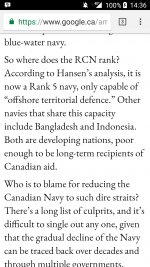Baz said:
Please provide a doctrinal quote, perferably Allied not Canadian, as to what you believe the real business of *a* navy is.
The reason I ask is because most blue water aspiring navies include power projection, littoral maneuver, and maritime based strike, 3 capabilities which Canada has forced the RCN to ignore.
Sure, I've cut out a lot of fluff but here's the
UK's version.
UK maritime doctrine:
The 3 core British maritime roles, war-fighting, maritime security and international engagement deliver effect across the full spectrum of military tasks, at sea and from the sea.
The ability to conduct war-fighting under-writes the ability to deliver maritime security and international engagement and this role has primacy. War-fighting may be used for a variety of reasons, but the physical protection of the UK’s territorial integrity, national security in a very literal sense, is the irreducible minimum requirement. Although there has been no threat of invasion for a long time, and neither is there one on the immediate horizon, this is not the case for some of the UK’s overseas territories. Therefore, British armed forces have a non-discretionary military task to provide ‘an independent ability to defend the overseas territories’
They go on to list the primary reasons for the navy at sea is: sea control, sea denial, fleet-in-being, cover and decisive battle. The application of force from the sea is the next chapter which include: maritime maneuver, maritime power projection (using sea control), proactive and reactive choices.
Wikipedia:
The strategic offensive role of a navy is projection of force into areas beyond a country's shores (for example, to protect sea-lanes, ferry troops, or attack other navies, ports, or shore installations). The strategic defensive purpose of a navy is to frustrate seaborne projection-of-force by enemies.
As soon as you have a navy you have power projection, even green/brown water navies in the strategic defensive sense (frustrate enemy actions). All blue water navies automatically are able to project power away from their own shores and thus are more useful strategically.
That's also from wikipedia:
Power projection (or force projection) is a term used in military and political science to refer to the capacity of a state "to apply all or some of its elements of national power - political, economic, informational, or military - to rapidly and effectively deploy and sustain forces in and from multiple dispersed locations to respond to crises, to contribute to deterrence, and to enhance regional stability."
- this is different than the UK definition.
Examples of power projection the RCN does are: securing sea lanes or sea control, showing the flag, compulsion/deterrence and it might be argued a limited humanitarian capacity and punitive capacity (depending on the target). Littoral maneuver (amphibious warfare) and maritime strike (includes shore bombardment and sea based air attacks) are only two components of power projection.
Canada is quite capable of power projection and has a limited maritime based strike capability (Land attack harpoons). The CSC (which is a first tier capability in my argument) will increase the maritime strike significantly with 127mm and the capacity to embark proper land attack missiles, and better SOF support.
The doctrine and goals are clear. Each coast is to to be able to provide a 4 warship task group with an AOR, embarked helo's and perhaps a submarine attached. This is the goal by 2022.
If I were to place the tiers of naval requirements the first tier would alway be to gain and maintain sea control as the primary uber alles reason for a navy. In that primary tier I would also place the requirement for being able to sustain operations away from our shores (requiring an AOR). This means bending all resources to ensure Canada has proper
warships and can sustain them far from Canada. It also means for defensive sea control proper submarines. When all these capabilities are complete (which they are currently not) THEN we can look at Mistrals.
Mistral and its capabilities are second tier. If it was first tier every navy in the world would buy them first and warships second. But they don't because they understand that littoral maneuver is secondary to sea control.


